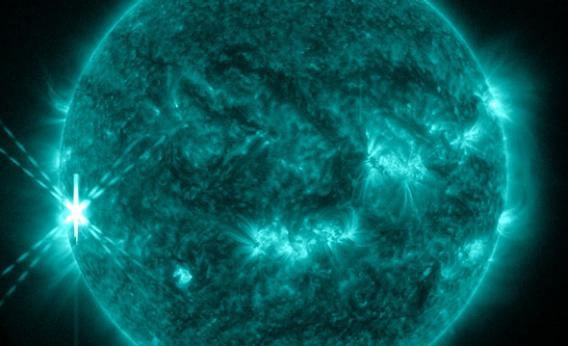Create a free profile to get unlimited access to exclusive videos, sweepstakes, and more!
The Sun Blasts Out a Pair of X-Class Flares

The Sun erupted again today, blasting out a pair of X-class flares within hours of each other, the first such high-energy flares since May. The image above is from NASA's Solar Dynamics Observatory (SDO), which stares at the Sun 24 hours a day to monitor activity. It shows the second flare, which occurred at 15:00 UTC (11:00 EDT) on October 25, 2013. The first flare blew off around 08:00.
Solar flares are caused by magnetic activity on the Sun. Super-hot plasma (ionized gas) rises from the Sunâs interior, carrying with it a strong magnetic field. The looping magnetic field lines (similar to the loops you see when you sprinkle iron filings on a piece of paper held over a bar magnet) rises with the gas, piercing the Sunâs surface. The loops can get tangled up, and can suddenly âshort circuitâ, snapping like springs under high tension. This releases the vast energies stored inside them â and I do mean vast; a single solar flare resulting from this kind of event can be the equivalent of millions of nuclear weapons all going off simultaneously!
Flares are classified by the X-ray energy they give off. There are five levels of flares: A, B, C, M, and X, each ten times more powerful than the previous. Each class is further subdivided into nine levels. An X3 flare is ten times more powerful than an M3, and three times as powerful as an X1, to give you an idea of how that works.
Specifically, todayâs first flare was an X1.7, and the second topped out at X2.1. These are both pretty strong. The last time the Sun emitted X flares was in May, when it ripped out four in a row.
Flares release so much energy they can affect us here on Earth, basically by whacking the Earthâs magnetic field. X-class flares can cause radio blackouts at the lower end, and even power blackouts if they are at the top of the scale. They also have to be aimed at Earth; it looks like neither or todayâs flares are in the right position to do much to us (though if you live at high latitudes you should keep your eyes open for aurorae anyway over the next few days). Iâll note that our atmosphere protects us from any direct effects, so weâll be fine. If the flares were big enough and Earth-directed, astronauts in space might have to take measures to protect themselves, though, finding shelter on the space station.
The timing is funny; just yesterday I mentioned the Sun was being pretty quiet these days, despite a huge eruptive filament launching itself into space a couple of weeks ago. As I have always said, the only way to know just what the Sun is going to do is watch it and find out!
And thatâs precisely why we have SDO and so many other observatories monitoring our star. We want to learn more about it, of course, since itâs the main source of light and heat for our planet. But it also can affect our modern civilization profoundly, and not always in a positive way. We have hundreds of billions of dollars of satellites in orbit over Earth, and theyâre at risk if the Sun decides to throw a particularly nasty hissy fit.
In this case â as usual âscience and self-interest overlap pretty comfortably.
If you want to keep track of what the Sunâs doing, I suggest following Space Weather Trackers on Facebook, and the Space Weather Prediction Center (here in my home town of Boulder!). Youâll get plenty of fascinating information.














